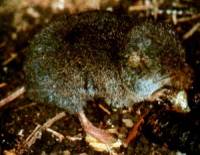This article includes a list of general references, but it lacks sufficient corresponding inline citations .(April 2015) |
| Smoky shrew [1] | |
|---|---|
 | |
| Museum specimen | |
| Scientific classification | |
| Kingdom: | Animalia |
| Phylum: | Chordata |
| Class: | Mammalia |
| Order: | Eulipotyphla |
| Family: | Soricidae |
| Genus: | Sorex |
| Species: | S. fumeus |
| Binomial name | |
| Sorex fumeus Miller, 1895 | |
 | |
| Smoky shrew range | |
The smoky shrew (Sorex fumeus) is a medium-sized North American shrew found in eastern Canada and the northeastern United States and farther south along the Appalachian Mountains.
Contents

